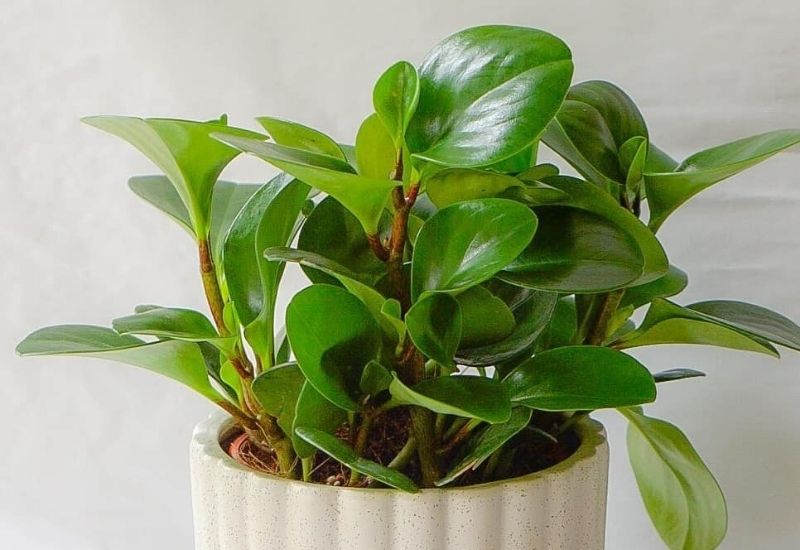
You may know Peperomia obtusifolia by one of its many common names including baby rubber plant, American rubber plant, Peperomia green, or pepper face plant!
A member of the abundant genus Peperomia, which contains over 1500 species, the Peperomia Obtusifolia itself also comes in a few varieties that are mostly distinguishable by their slightly different colors.
It is instantly recognizable with its plump leaves that are similar to succulent leaves in appearance and in their ability to store water. The leaves are usually dark green but variants may have light green, white, and yellow marbling.
The compact size and attractive foliage of the baby rubber plant makes it a popular houseplant, especially as it is considered to be fairly easy to care for, compared to other tropical indoor plants.
Well suited for windowsills or terrariums, the Peperomia obtusifolia can grow in most indoor environments, as long as a few basics are taken care of.
This baby rubber plant care guide will outline everything you need to know about caring for this cheerful houseplant, and help you troubleshoot any issues you may have along the road.
Peperomia Obtusifolia Quick Care Tips
- The Peperomia obtusifolia should be grown in peat based soil that has good drainage.
- Place your baby rubber plant in a bright spot, with no direct sunlight for dark green varieties but a few hours of direct light for variegated plants.
- Keep in a room with temperatures between 65 and 75℉.
- Soil should be kept slightly moist and fertilized infrequently.
- Although it will enjoy humid environments of 40-50%, it is not essential to maintain high humidity levels.
Plant Overview
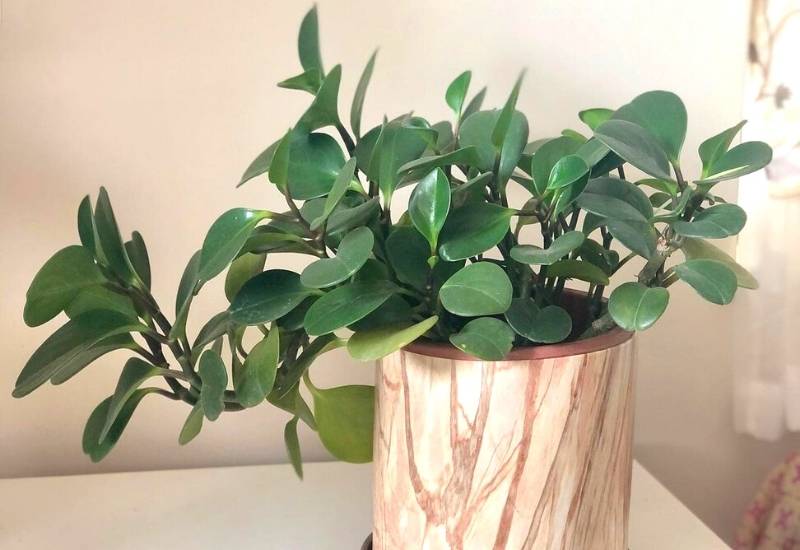
Scientific Name | Peperomia obtusifolia |
Horticultural Classification | Family: Piperaceae, Genus: Peperomia |
Common name | Baby rubber plant, American rubber plant |
Native region | South and Central America |
Average size | 8-12 inches |
Sunlight needs | Moderate and indirect |
Temperature needs | 65-75℉ |
Water needs | Water when the top layer of soil begins to dry out. |
Soil needs | Peaty and loamy soil with good drainage. |
Bloom time | Small flowers appear throughout the spring and summer. |
Flowers | Green |
Peperomia obtusifolia is a small plant that usually grows to around 10 inches but can reach 1 foot in certain growing conditions. It is a flowering, succulent-like epiphyte, meaning that in the wild it would grow on other plants – like tree branches.
It is fast growing and may require occasional pruning, and grows well in a container with other tropical plants or succulents. It is usually kept as an indoor plant, but can be grown outdoors in USDA growing zones above 10a, but should be kept out of intense, direct sunlight.
The stem and branching arms are thick like the water-filled leaves, and grow upright and slightly outwards, reaching up to a 1ft across.
Since water stores are typically in the leaves and upper body of the plant, the root system of the obtusifolia is quite small. The flowers will usually bloom in the late summer, and are a greenish-white color.
Tips for Taking Care of The Peperomia Obtusifolia (Baby Rubber Plant)
Read on to explore the specifics of caring for this plant, and troubleshoot any issues you are encountering.
1: The Baby Rubber Plant Prefer A Warm Environment
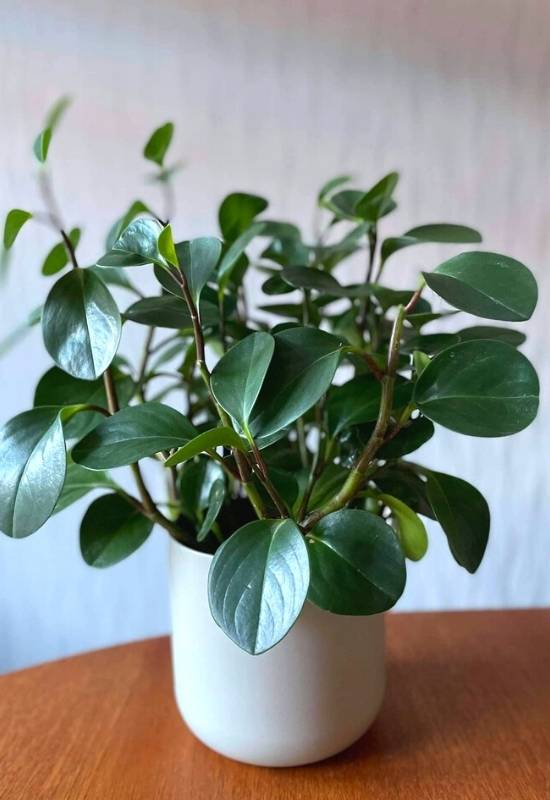
Optimal temperature for this plant is between 65 -75 ℉, which is probably around the temperature you would keep your house at anyway. It can tolerate up to 80℉, but any hotter and the plant will become stressed, likewise with temperatures below 50℉.
When selecting a spot, make sure it isn’t next to a heating vent or drafty window, as the baby rubber plant does not like inconsistent temperatures and it can cause browning leaf tips.
2: Baby Rubber Plant Thrives In Medium To Bright Indirect Light
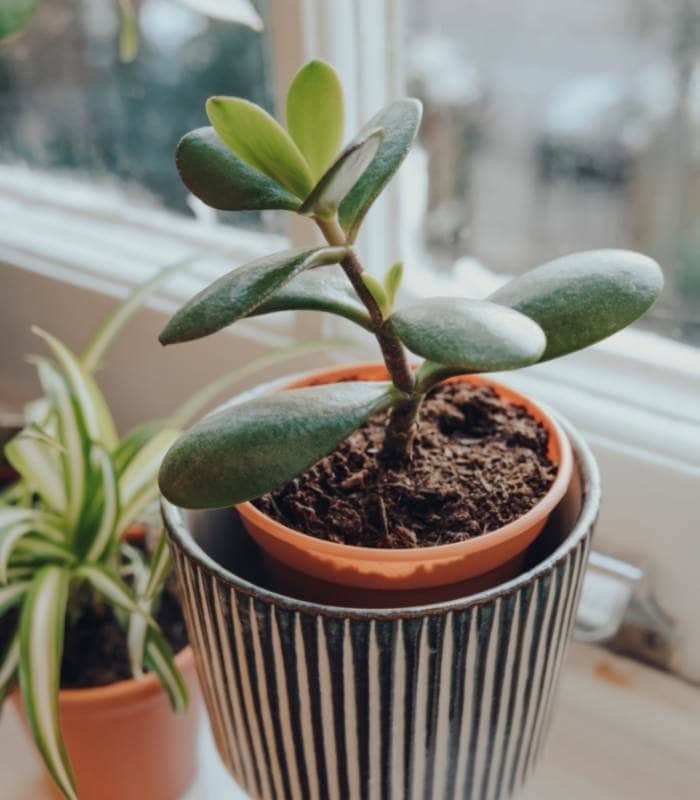
The dark green varieties do best in bright spaces that receive indirect light. This is the standard for a lot of tropical indoor plants, as direct sunlight can burn or discolor the leaves, and this is true for the fleshy leaves of the Peperomia obtusifolia too.
However, the variegated baby rubber plants that have some colored marbling on the leaves can benefit from some occasional direct light, but no more than a couple hours per day.
A good spot for variegated varieties is near a window that is East or West facing, where the plant can receive lots of light but the sun doesn’t shine through all day.
While baby rubber plants can tolerate lower light conditions, if it becomes too dark you will find that the leaves grow further apart from each other and the bushy appearance is lost.
The variegated plants will also begin to lose their attractive marbling if there is insufficient light, but fret not – once you move them to a brighter spot they will regain it!
3: Humidity is Ideal, not Essential
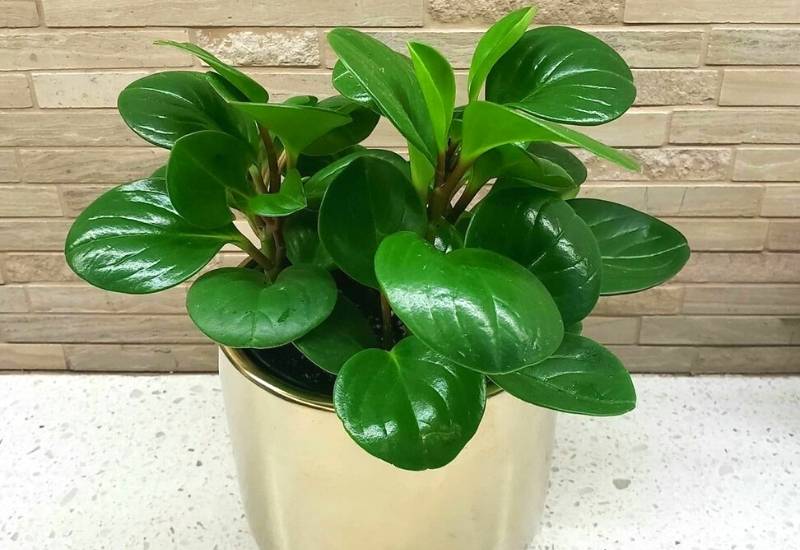
Many tropical indoor plants are a bit high maintenance when it comes to humidity. The Peperomia obtusifolia likes humidity levels to be at around 40-50%, but it is not essential for the plant to do well.
The plant is popular for this reason, and many owners who live in dry conditions where the leaf tips of tropical plants usually turn brown, report that the baby rubber plant is surprisingly unaffected!
Most homes should be fine with their normal humidity levels, but if you are concerned keep your plant in the kitchen or bathroom where the air is naturally more humid.
You can also mist your plant occasionally, but be wary not to let water pool on the leaves as they can begin to rot if constantly wet.
4: Plant The Peperomia Green In Well-Drained Potting Mix
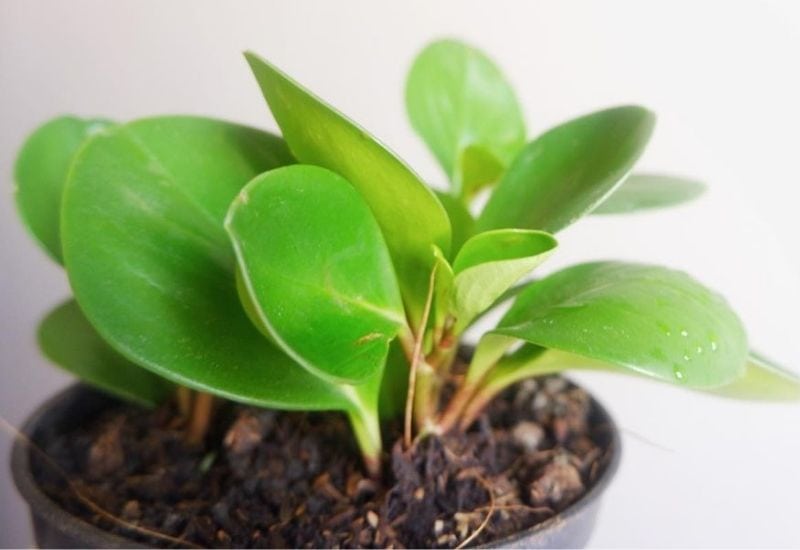
Your Peperomia obtusifolia, like all Peperomias, will grow best in rich, aerated soil with good drainage. It is not a succulent but has many similar qualities, making it a ‘succulent-like’ plant, so it will grow well in potting soils designed for cacti and succulents which is usually well aerated and sandy.
Loamy soils are also good, and can be amended with compost to create a richer nutrient base. Orchid bark, horticultural sand, and pumice are all good additions to improve drainage.
Peat moss is a popular addition because it is both nutrient rich and light, but consider coco coir, which fulfills the same purpose but is much more sustainable.
If building your own soil, you can try a mix of 30% cacti/succulent potting soil, 30% compost, 15% orchid bark, 15% coco coir.
5: Fertilize Only When Your Houseplants Are Actively Growing
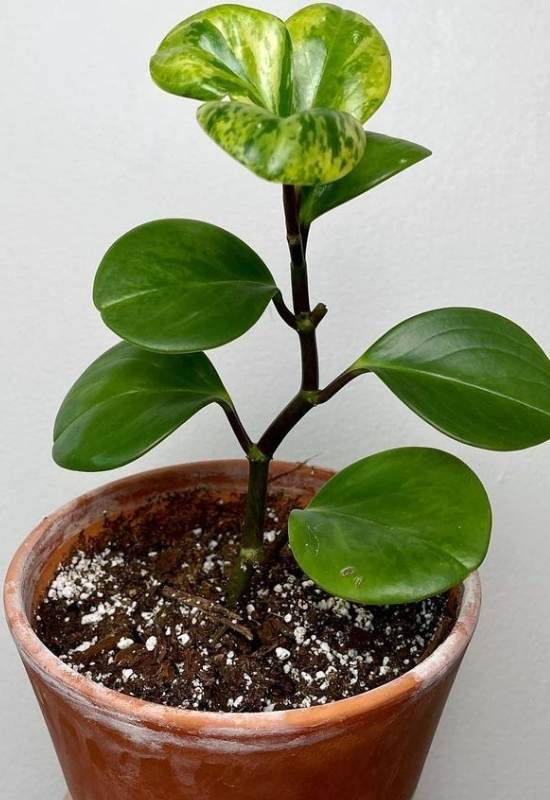
Since peperomias are succulent-like and do not feed heavily through their roots they don’t require much fertilizing.
Every 6 weeks during the spring and summer with a diluted fertilizer is fine, and try using a non-synthetic option like compost tea. They are slower growing in the fall and winter and it isn’t necessary to feed them during this time.
6: Water Deeply, Rather Than Lightly and Frequently
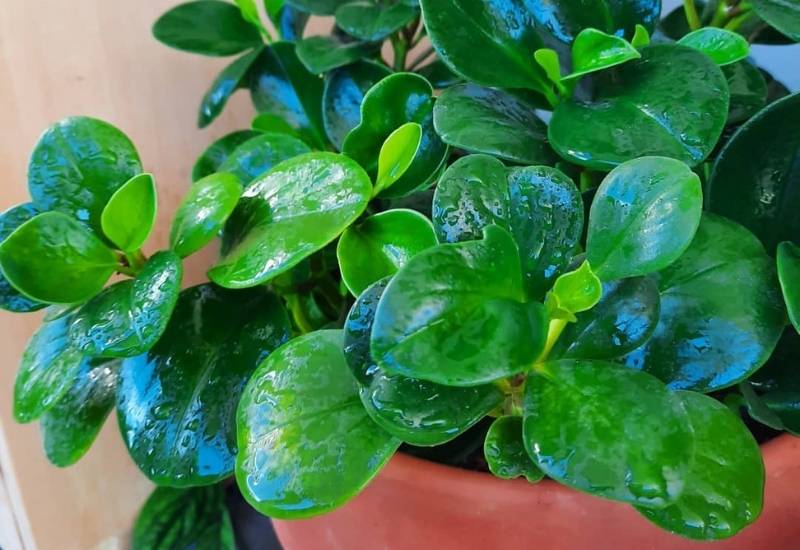
The Peperomia obtusifolia should be watered around once a week in the spring and summer, but you should adjust this frequency according to how much light it receives and how dry your house is.
Let the top inch of soil dry out between waterings to prevent the occurrence of root rot. In the winter, it likely only needs watering every 2- 3 weeks as it stores water in its fleshy leaves.
Water thoroughly when you do, giving the plant a good deep drink. Just make sure all the excess water is draining out from the bottom of the pot and that the roots aren’t sitting in water.
Root rot develops in poorly draining soils when the roots are constantly kept in soggy conditions and they begin to deteriorate. It is very difficult to remedy once it has set in, and is a common outcome from overwatering.
6: Prune Your Baby Rubber Plant To Encourage New Growth

You can prune your baby rubber plant by using a disinfected cutting tool (scissors or pruning shears) to snip off the tops of wiley stems. Prune long, leggy branches if you want your plant to grow more bushy and compact.
Stems that are allowed to grow too tall can cause the plant to topple, since the fleshy leaves are slightly heavier than average. Pruning does not need to be done frequently, and pruned stems can be used for propagation.
7: Propagate Peperomia Obtusifolia through Division or Cuttings
Peperomia plants are easily propagated by root division, or by taking stem cuttings and rooting them in soil or water. While it is possible to save seeds from the flowers, it is certainly more difficult and unreliable.
If you have a variegated baby rubber plant and you want a new variegated plant, you will need to use cuttings to reproduce the variegated leaves. Saving seeds from variegated plants will not necessarily produce the same baby variants.
Whether you propagate your plants through root division or stem cuttings, make sure you do it in the spring, as new roots will develop and adjust better in warmer conditions.
Also ensure that your cutting tools are sharp to avoid raggedy edges and damaged roots! With that in mind, read on to explore how to propagate by root division and stem cuttings.
Root Division
To divide your Peperomia Obtusifolia through root division, begin by un-potting your plant and remove as much soil as you can from around the roots. The roots of this plant are quite small so just be gentle when teasing soil away.
Then take a sharp, disinfected cutting implement and slice away a portion of the root ball that has some small growth coming from it.
If you have a large mother plant, you can take several root cuttings. Repot the new cuttings in smaller pots with the same soil mix mentioned earlier in this article.
Propagate Peperomia Obtusifolia By Stem Cuttings
There are a few more steps to follow when propagating through stem cuttings, but it is a good way to produce new plants without having to unpot the parent plant while giving it a good pruning at the same time. You can choose to root your cuttings in water or soil.
Rooting Peperomia Obtusifolia in Water
Many prefer rooting new cuttings in water as you can clearly see whether it is working and easily track the progress of new root development. Here are the steps to :
Rooting Peperomia Obtusifolia in Soil
If you want to take cuttings from an already small plant, rooting in soil may be better as it requires smaller sections to be cut from the plant.
8: Control Insect Pests Commonly Attack
Fortunately, Peperomia obtusifolia plants are known to be fairly resistant to pest invasions and diseases.
As mentioned before, these guys are pretty low maintenance and very much appreciated for that reason!
All the same, it is a good idea to keep an eye out for common houseplant pests, and nip any problems in the bud.
Spider Mites
One of the most common pests for indoor plants, spider mites can prey on your baby rubber plant as well- especially if they are already present on nearby plants. Their signature webbing around the stems will alert you to their presence, as will yellow spots on the leaves.
Prevent them by showering the leaves when you water your plant, but always make sure to pat them dry afterwards to avoid pooling water. If necessary, apply neem oil to affected areas and that should get rid of them.
Fungal Infections
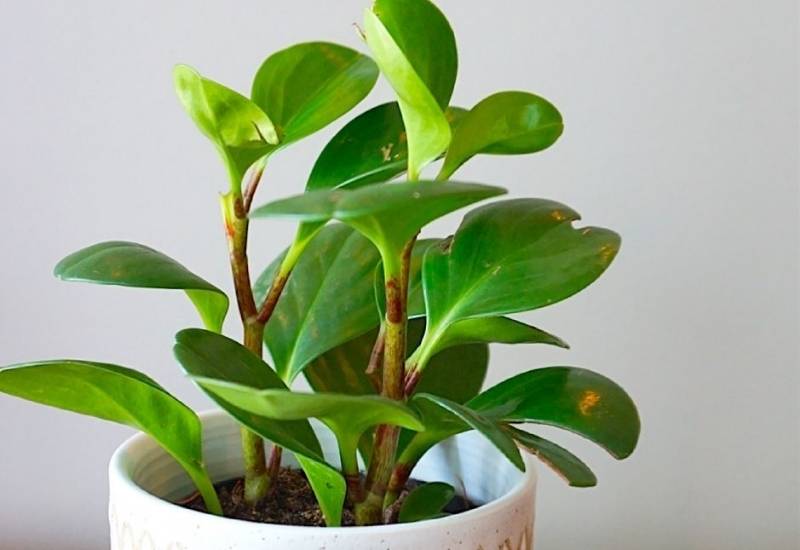
Any tropical plant can develop fungal diseases from too much moisture or insufficient air flow between plants.
The best tactic is prevention, so don’t let water sit on the leaves, use sterilized tools and containers, and always make sure your plants are well spaced and not crowded.
If fungi do develop, you can try spraying a baking soda solution applied to infected areas, but it is generally best to remove infected leaves, before spores spread to the rest of the plant. For serious infections, use an organic fungicide.
Why are the leaves of my baby rubber plant falling off?
The leaves of the Peperomia obtusifolia will begin to die and fall off when the temperature is too cold. Move your plant to a warmer spot where it receives more heat.
Why is my plant growing so slowly?
Although it is a tropical plant, the baby rubber plant will respond to seasonal changes. In the fall and winter the plant will grow more slowly, and this is normal.
If you accidentally tried to propagate it at this time of year, the cuttings may not survive or they will be rooting much more slowly.
Slow growth can also be due to a lack of oxygen at the root level, so switch your soil base to something lighter and more aerated to allow the roots to breathe.
Why are the leaves of my Peperomia obtusifolia turning yellow?
Yellowing leaves on peperomia obtusifolia could be due to under watering or lack of nutrients. Feed your plant with a fertilizer rich in potassium and nitrogen, and prune off yellow leaves.
If new leaves begin to yellow, and can adjust your watering schedule to be slightly more frequent but be careful not to drown the plant.
If with slightly moist and rich soil the leaves are still yellowing, move the plant to a brighter spot where the plant receives more light.
Why is my plant drooping?
Drooping Peperomias can be from too much or too little water- very tricky! If you typically water infrequently and you live in a hot or dry climate, water or mist your plant a little more frequently and see if it makes a difference.
If the stem is mushy in any spots, it is definitely overwatering and root rot may be developing. Do some emergency surgery and cut away any rotting stem and root material, and re-pot in fresh, well-draining soil.
Is this plant safe for children and pets?
Yes, the Peperomia obtusifolia is non-toxic to animals and humans. It is still generally a good practice to keep the plant out of reach as a toppling pot could hurt children.
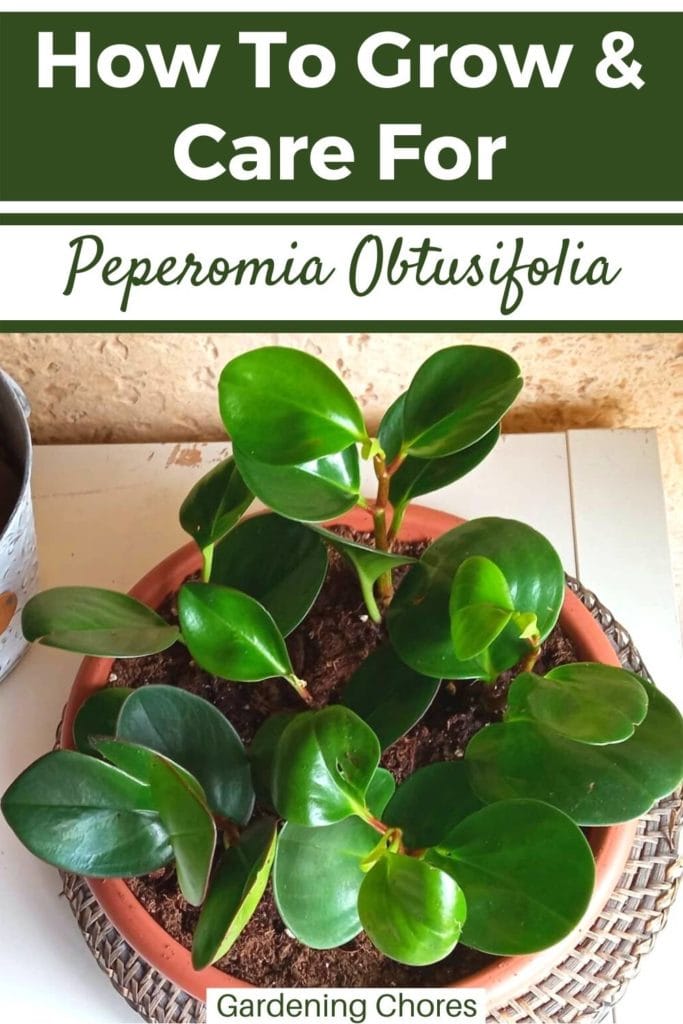

Written By
Amber Noyes
Amber Noyes was born and raised in a suburban California town, San Mateo. She holds a master’s degree in horticulture from the University of California as well as a BS in Biology from the University of San Francisco. With experience working on an organic farm, water conservation research, farmers’ markets, and plant nursery, she understands what makes plants thrive and how we can better understand the connection between microclimate and plant health. When she’s not on the land, Amber loves informing people of new ideas/things related to gardening, especially organic gardening, houseplants, and growing plants in a small space.


Is the baby rubber plant suitable for outdoor planting on a lakeshore beneath cypress trees in Orlando FL?
Thanks.
While the baby rubber plant (Peperomia obtusifolia) is a lovely houseplant, it may not be the best choice for outdoor planting on a lakeshore beneath cypress trees in Orlando, FL.
The baby rubber plant prefers to be grown in a warm, indoor environment with bright, indirect light. It may not survive the cooler winter temperatures that can occur in Orlando, especially if it is planted outdoors. Additionally, the soil in that area may be too acidic for the plant to thrive.